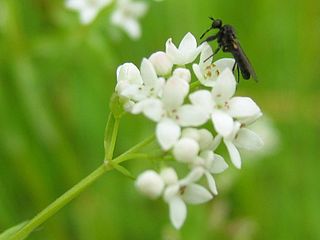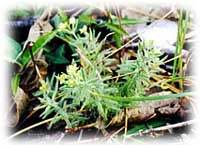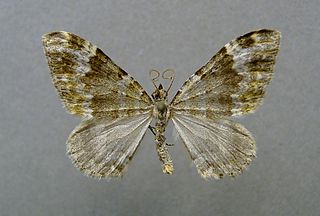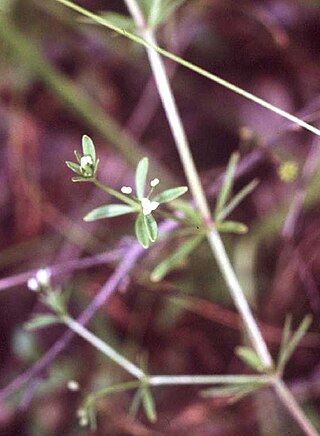
Galium is a large genus of annual and perennial herbaceous plants in the family Rubiaceae, occurring in the temperate zones of both the Northern and Southern Hemispheres. Some species are informally known as bedstraw.

Galium verum is a herbaceous perennial plant of the family Rubiaceae. It is widespread across most of Europe, North Africa, and temperate Asia from Israel, Lebanon and Turkey to Japan and Kamchatka. It is naturalized in Tasmania, New Zealand, Canada, and the northern half of the United States. It is considered a noxious weed in some places.

Galium triflorum is a herbaceous plant of the family Rubiaceae. It is widespread in northern Europe, eastern Asia and North America. The plant is considered a noxious weed in New York, Pennsylvania, Vermont, New Hampshire, Connecticut and Massachusetts.

Galium album, the white bedstraw or hedge bedstraw, is a herbaceous annual plant of the family Rubiaceae.

Galium mollugo, common name hedge bedstraw or false baby's breath, is a herbaceous perennial plant of the family Rubiaceae. It shares the name hedge bedstraw with the related European species, Galium album.

Galium palustre, the common marsh bedstraw or simply marsh-bedstraw, is a herbaceous annual plant of the family Rubiaceae. This plant is widely distributed, native to virtually every country in Europe, plus Morocco, the Azores, Turkey, Turkmenistan, Western Siberia, Greenland, eastern Canada, St. Pierre & Miquelon, and parts of the United States. The species is classified as a noxious weed in New York, Pennsylvania, Massachusetts, Connecticut, Vermont and New Hampshire. It is considered naturalized in Kamchatka, Australia, New Zealand and Argentina.

Galium uliginosum or fen bedstraw is a plant species of the genus Galium. It is widespread across most of Europe as well as Morocco, Western Siberia, Turkey, Kazakhstan and Xinjiang. It is reportedly naturalized in New Zealand, Greenland and the Crozet Islands.

Galium boreale or northern bedstraw is a perennial plant species of the Rubiaceae family. It is widespread over the temperate and subarctic regions of Europe, Asia and North America including most of Canada and the northern United States.

Galium saxatile or heath bedstraw is a plant species of the genus Galium. It is related to cleavers.

Galium sylvaticum, commonly known as Scotch mist or wood bedstraw, is a plant species of the genus Rubiaceae. Its genus name, Galium, is derived from the Greek word for "milk," apparently because some species have been used to curdle milk.

Galium californicum is a species of flowering plant in the coffee family known by the common name California bedstraw.

Galium aparine, with common names including cleavers, clivers, catchweed and sticky willy among others, is an annual, herbaceous plant of the family Rubiaceae.

Coenotephria is a genus of moths in the family Geometridae described by Prout in 1914. Its species are primarily found in Europe and Asia.

Galium parisiense is a species of flowering plant in the family Rubiaceae known by the common name wall bedstraw. A native of the Mediterranean area and Western Europe, it has become naturalised in North America and other parts of Europe.

Galium trifidum is a species of flowering plant in the coffee family, known by the common name three-petal bedstraw. It grows widespread in the arctic, temperate and subtropical regions of the Northern Hemisphere: northern and central Asia, northern and eastern Europe and much of North America.

Coenotephria salicata, the striped twin-spot carpet, is a moth of the family Geometridae. It was first described by Michael Denis and Ignaz Schiffermüller in 1775 and is found in most of Europe.

Epirrhoe galiata, the galium carpet, is a moth of the family Geometridae.

Epirrhoe molluginata is a moth of the family Geometridae. It is found from the southern part of central Europe to the Caucasus.
Coenotephria ablutaria is a moth of the family Geometridae. It was described by Jean Baptiste Boisduval in 1840. It is found in Spain, France, Italy, Austria, Switzerland, Slovenia, Bulgaria, Romania, Serbia, Croatia, Albania, North Macedonia, Greece, Ukraine, as well as on Sardinia, Corsica, Sicily, Malta, Crete and Cyprus. Outside of Europe, it is found in Asia Minor and the Near East.



















